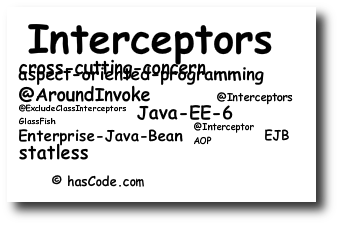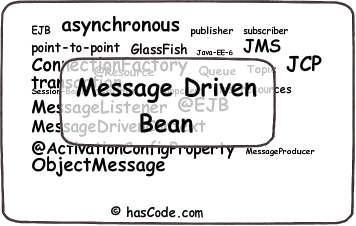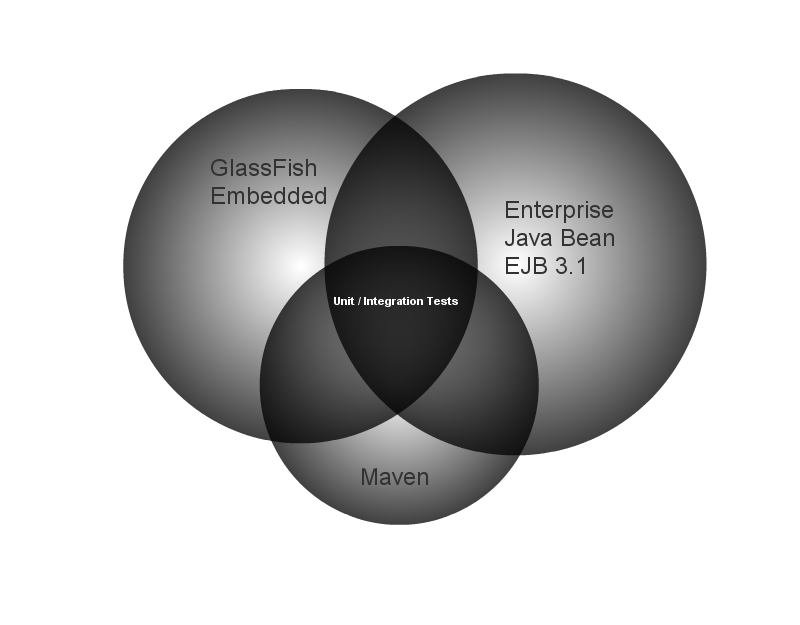Articles Tagged ‘glassfish’
Sunday, December 21st, 2014
Especially when it comes to testing, setting up a decent environment for a secured Java EE web application isn’t always an easy thing to do.
In the following tutorial I’d like to demonstrate how to create a secured web application using form-based authentication and a JDBC realm to fetch users and roles and how to run the application in an embedded container for testing and development.
Additionally I’d like to show how to write and run integration tests to verify the security setup using a setup of Maven, Embedded GlassFish, Arquillian, jUnit and rest-assured.
(more…)
Tags: arquillian, authentication, eclipselink, glassfish, h2, it, javaee, jdbc, jdbcrealm, junit, maven, rest, rest-assured, security, testing
Posted in Enterprise, Java | 1 Comment »
Sunday, November 9th, 2014
Having written two articles about different websocket based chat server implementations in Java, I was recently asked how an implementation of the client side would look like in Java.
That’s why I added this article to demonstrate how to create a websocket chat client applications within a few steps with the Java API for Websocket.
In the following tutorial, we’re going to write a text-based chat client for the console first and afterwards we’re going to program a chat client with a graphical user interface, implemented in JavaFX.
(more…)
Tags: chat, client, fxml, glassfish, java fx, javafx, json, jsr-353, jsr-356, maven, websocket, websockets
Posted in Java, Web | 14 Comments »
Tuesday, August 26th, 2014
There are several ways to aggregate and report application performance indicators in a Java application. One common way here is to use Java Management Extensions (JMX) and MBeans.
The Yammer Metrics Library eases this task for us and simplifies the aggregation of different reports.
In the following tutorial, we’re going to set up a full Java EE 7 web application by the help of Maven archetypes and we’re running the application on WildFly application server that is downloaded and configured completely by the WildFly Maven Plugin.
Finally our application is going to use the Java API for JSON Processing to parse lists of public repositories from the Bitbucket REST API to aggregate different reports, exported via JMX so that we’re finally able to view these reports with jconsole or jmeter.
(more…)
Tags: benchmark, bitbucket, discovery, gauge, glassfish, javaee, javaee7, jconsole, jmeter, jmx, json, jsonp, mbean, metrics, metrics-cdi, monitoring, performance, producer, wildfly, yammer
Posted in Enterprise, Java, Web | 7 Comments »
Monday, May 26th, 2014
Using dependency injection and aspect-oriented mechanisms like interceptors allow us to separate cross-cutting-concerns in our Java enterprise application, to control global aspects of our application and to avoid boilerplate code.
In the following short tutorial we’re going to create an aspect-oriented logger to protocol the initiating user, class and method called and the parameters passed to the method and finally we’re adding this interceptor to a sample RESTful web-service by adding a simple annotation.
(more…)
Tags: aop, authentication, basic-auth, cdi, di, ejb, glassfish, interceptor, javaee, javaee7, jax-rs, jaxrs, jee, logging, rest
Posted in Enterprise, Java | 2 Comments »
Monday, December 30th, 2013
JAX-RS 2.0 aka JSR 339 not also specifies the API to build up a RESTful webservice but also enhances the client side API to easen up the process of writing a client for a REST service.
In the following tutorial we’re building up a client for a ready-to-play REST service and explore the different new options e.g. how to handle requests in a synchronous or asynchronous way, how to add callback handlers for a request, how to specify invocation targets to build up requests for a later execution or how to filter the client-server communication using client request filters and client response filters.
(more…)
Tags: async, asynchronous, filter, glassfish, jackson, jax-rs, jaxrs, jersey, jsr-339, jsr339, rest, server, web, webservice
Posted in Java, Web Services | 13 Comments »
Tuesday, August 13th, 2013
Java EE 7 is out now and so I was curious to play around with the new specifications and APIs from in this technology stack.
That’s why I didn’t hesitate to add yet another websocket-chat tutorial to the existing ones on the internet in favour of gathering some experience with this technology and a possible integration using a GlassFish 4 server, the new Java API for JSON Processing for data serialization combined with custom websocket encoders/decoders and finally adding some Bootstrap and jQuery on the client side.
(more…)
Tags: bootstrap, chat, client, encoder, glassfish, grizzly, html5, Java, javaee, javascript, json, json-p, websocket, websockets
Posted in Enterprise, Java | 65 Comments »
Wednesday, May 29th, 2013
Recently I needed a quick solution to deploy a Java EE 6 web application on a GlassFish instance automatically and subsequent to a successful build of the project on the integration server.
It took only a few steps using Jenkins, Maven and the Cargo plugin and I’d like to share this quick solution with you here.
(more…)
Tags: cargo, cd, continouous deployment, continuous delivery, continuous integration, git, glassfish, hudson, java ee, jee, jenkins, maven
Posted in Development, Enterprise, Java | 3 Comments »
Sunday, April 28th, 2013
Database migrations often are a necessity in the application development and maintenance life-cycle.
Whenever we need to apply changes to the database structure, insert new data fragments and in doing so want to be sure that this all happens with some control and versioning.
The following tutorial shows how implement this for a simple Java EE 6 web application to be run on a GlassFish application server in a few quick steps using the Flyway framework, an eager initialized Singleton EJB and some Maven wiring.
(more…)
Tags: database migration, ejb, flyway, glassfish, javaee, jee6, singleton, startup
Posted in Enterprise, Java | 11 Comments »
Friday, June 22nd, 2012
Creating cronjobs or scheduled service executions is made really easy in Java EE 6. Scheduled tasks may be created in a programmatical style or simply by adding some annotations to an EJB.
In the following tutorial we’re creating some simple scheduled tasks and let them run on an embedded GlassFish instance using the Maven Embedded GlassFish plugin..
(more…)
Tags: cron, embedded, Enterprise, glassfish, java ee, jee, maven, quartz, scheduleexpression, scheduler, service, task, timer, timer service
Posted in Enterprise, Java | 4 Comments »
Thursday, April 26th, 2012
Now that the long awaited stable version of the Arquillian framework is released I wanted to demonstrate some interesting features of this framework that really eases writing and running of integration tests for Java EE 6 applications in many different ways.
In the following tutorial we are going to create some real-world examples using Enterprise JavaBeans, Contexts and Dependency Injection, the Java Persistence API and we’re finally running Drone/Selenium tests against a JEE Web Application that is using Java Server Faces.
(more…)
Tags: arquillian, cdi, drone, ejb, glassfish, integration test, java ee, jboss, jee, jpa, jsf, selenium, tdd
Posted in Enterprise, Java, testing | 11 Comments »
Tuesday, September 20th, 2011
 Today we’re going to take a look at the Maven Embedded GlassFish Plugin and how it allows us quick creation of GlassFish server instances in no time and Java EE 6 application deployment.
Today we’re going to take a look at the Maven Embedded GlassFish Plugin and how it allows us quick creation of GlassFish server instances in no time and Java EE 6 application deployment.
With a few lines of configuration in your Maven’s pom.xml we’ve got a running GlassFish instance and are able to redeploy our application fast by pressing enter in our console.
In the following tutorial we’re going to build a Java EE 6 Web Application with a stateless session bean and a web servlet and finally deploy – and redeploy the application using the Maven GlassFish Plugin.
(more…)
Tags: deployment, ejb, embedded, Enterprise, glassfish, javaee, jee, maven, servlet
Posted in Enterprise, Java | 7 Comments »
Wednesday, August 17th, 2011
 Aspect oriented programming and the definition of cross-cutting-concerns is made easy in Java EE 6 using interceptors.
Aspect oriented programming and the definition of cross-cutting-concerns is made easy in Java EE 6 using interceptors.
In the following tutorial we’re going to take a look at the different possibilities to apply interceptors to your EJBs at class or method level and how to setup a GlassFish instance to run the examples.
(more…)
Tags: aop, aspect, ejb, glassfish, interceptor, java ee, jee, servlet
Posted in Enterprise, Java | No Comments »
Sunday, June 5th, 2011
 Message Driven Beans are no new concept due to the fact that they exist since EJB 2.0 but in Java EE 6 and the EJB 3.0 specification it is even more fun to use them.
Message Driven Beans are no new concept due to the fact that they exist since EJB 2.0 but in Java EE 6 and the EJB 3.0 specification it is even more fun to use them.
In this tutorial we’re going to take a look at the specification and create an example application that transfers some objects via the Java Message Service to a Message-Driven Bean deployed on a GlassFish application server.
If you’re not interested in theory please skip to chapter 6 and directly start creating an application – otherwise we’ll begin with a short introduction into the JMS terminology and the concept of a Message-Driven-Bean..
(more…)
Tags: asynchronous, consumer, ejb, Enterprise, glassfish, java ee, jee, jms, mdb, message driven, messaging, publisher, tutorial
Posted in Enterprise, Java | 4 Comments »
Tuesday, February 8th, 2011
Java EE 6 is out and it indeed offers an interesting stack of technologies. So in today’s tutorial we are going to build a small sample web application that builds on this stack using Enterprise JavaBeans, Java Persistence API, Bean Validation, CDI and finally Java Server Faces and PrimeFaces.
The application we’re going to develop is a simple blog app that allows us to create new articles, list them and – finally delete them. We’re also covering some additional topics like JSF navigation, i18n, Ajax-enabled components and the deployment on the GlassFish application server.
(more…)
Tags: bean, bean validation, cdi, eclipselink, ejb, example, glassfish, hibernate, IoC, java ee, javaee, jee, jndi, jsf, jsr-303, jsr-316, jsr-317, jsr-318, maven, mojarra, primefaces, toplink, tutorial, validator, weld
Posted in Java | 85 Comments »
Saturday, January 1st, 2011
 Are you playing around with the shiny new 3.1 EJB API?
Are you playing around with the shiny new 3.1 EJB API?
Using Maven for your Java projects?
Need an easy way to write and execute tests for your EJBs that depends on an Java Application Server?
No problem using Maven Archetypes, the Maven EJB Plugin and the GlassFish embedded Application Container..
(more…)
Tags: application server, arquillian, bean, ejb, embedded, enterprise java bean, example, glassfish, java ee 6, jee, jeeunit, jndi, jsr-318, junit, maven, testing, tutorial
Posted in Java | 8 Comments »
Saturday, June 5th, 2010
In this short tutorial we are going to build a Java Server Faces Web-Application using JSF2.0, Facelets, Maven and Hibernate as ORM Mapper.
The goals for this first step are: Setting up the project structure using Maven, defining a frame template/decorator and a registration facelet, creating a managed bean and mapping it’s values to the facelet, adding some basic validation, displaying validation errors and finally adding a navigation structure.
In step2 of this tutorial we are going to add persistence using Hibernate, add some security, create a custom UI component and add some AJAX.
The Mojarra JSF implementation is used for this tutorial – perhaps I’m going to post more about the MyFaces implementation in another tutorial.
(more…)
Tags: eclipse, example, facelet, glassfish, hibernate, java server faces, jee, jsf, jsf 2, jsf2, maven, mojarra, mvc, servlet, tomcat, tutorial
Posted in Development, Java | 6 Comments »



